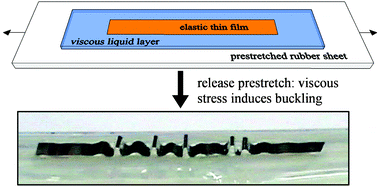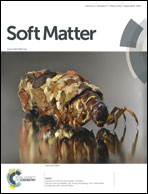Wrinkling and folding of thin films by viscous stress†
Abstract
We examine the buckling of a thin elastic film floating on a viscous liquid layer which is itself supported on a prestretched rubber sheet. Releasing the prestretch in the rubber induces a viscous stress in the liquid, which in turn induces a compressive stress in the elastic film, leading to buckling. Unlike many previous studies on wrinkling of floating films, the buckling process in the present study is dominated by viscous effects whereas gravitational effects are negligible. An approximate shear lag model predicts the evolution of the stress profile in the unbuckled film that depends on three parameters: the rate at which the prestretch is released, the thickness of the liquid layer, and the length of the elastic film. A linear perturbation analysis is developed to predict the wavelength of wrinkles. Numerical simulations are conducted to predict nonlinear evolution of the wrinkle wavelength and amplitude. Experiments using elastic polymer films and viscous polymer liquids show trends that are qualitatively consistent with the predictions although quantitatively, the experimentally-observed wrinkle wavelengths are longer than predicted. Although this article is focused only on small-strain wrinkling behavior, we show that application of large nominal strains (on the order of 100%) leads to sharply localized folds. Thus this approach may be useful for developing buckled features with high aspect ratio on surfaces.


 Please wait while we load your content...
Please wait while we load your content...